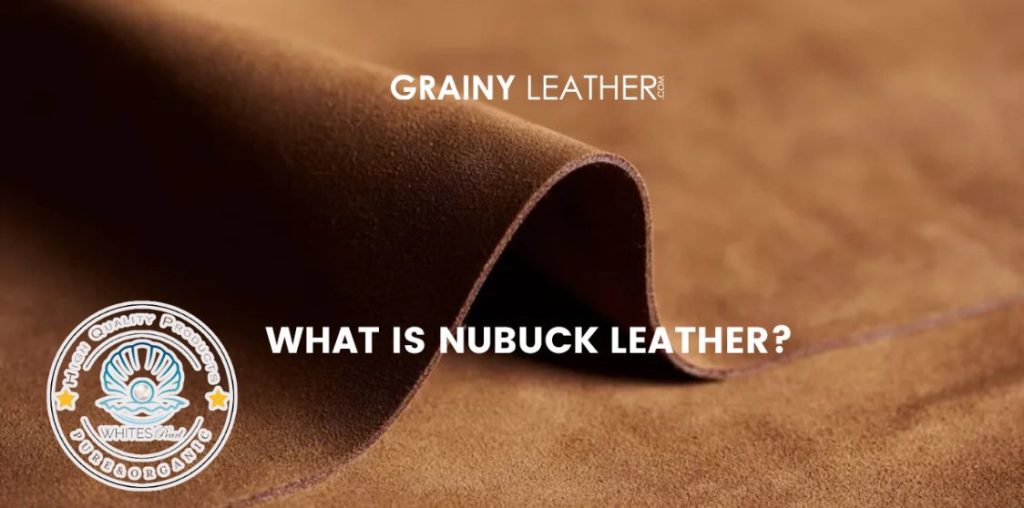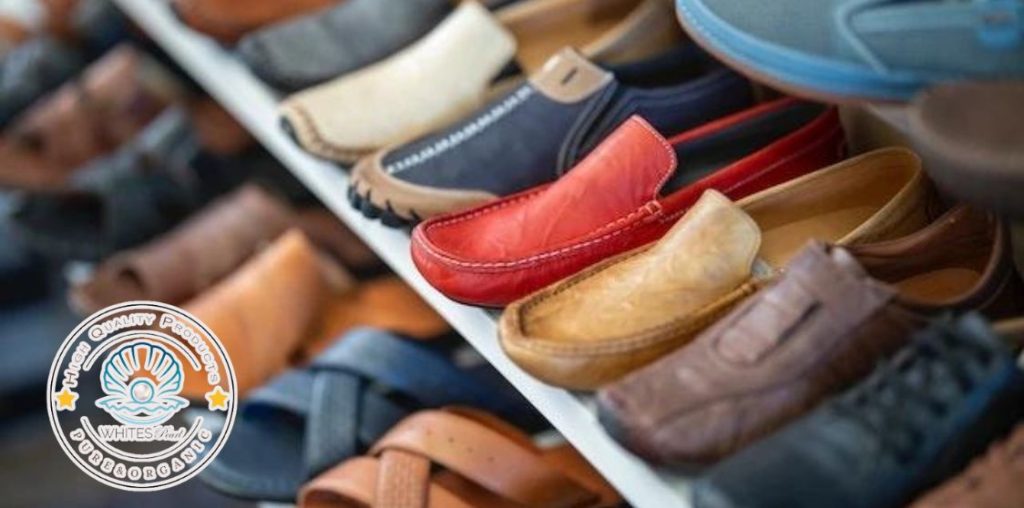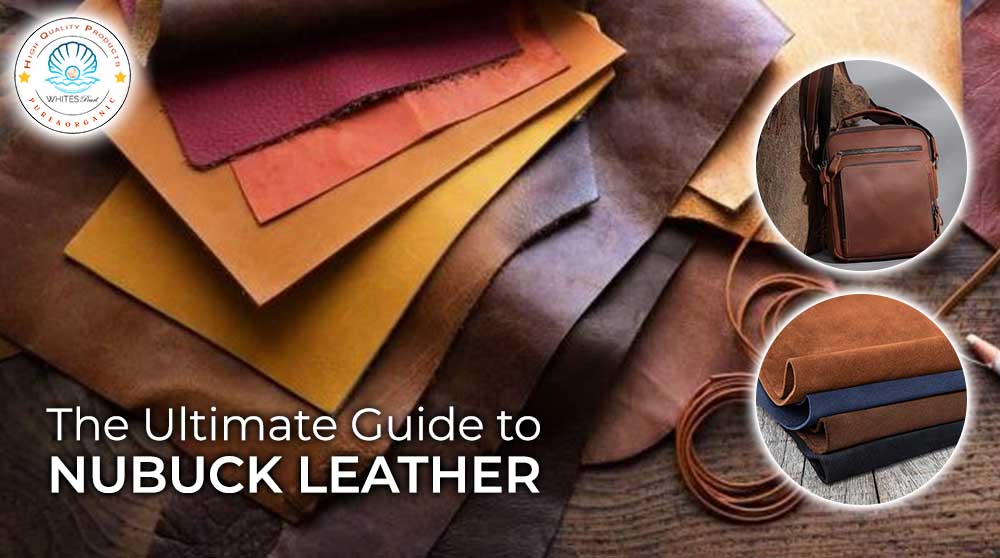
When it comes to leather end products, the type of leather used plays a vital role in determining its durability, quality as well as aesthetics. In the world of leather, there is a vast variety of leather available. Each type if leather harbors its own distinct appeal and characteristics that make it stand out from the rest. Among these types, one is known as Nubuck leather. Nubuck leather is celebrated for its suede surface and soft feel.
In this article, we will explore what Nubuck leather is, how it is made, and what are its advantages and disadvantages.
The Ultimate Guide to Nubuck Leather
Nubuck Leather – What is It and How it Differs from the Rest?

Nubuck Leather is a unique leather that is lauded for its velvety texture and luxurious softness. Unlike most leather which is smooth and shiny, Nubuck harbors a matte finish and a suede surface that has a pleasing feel to it. this texture of Nubuck is achieved via the process of sanding or buffing. During the production of Nubuck leather, the top grain or the outer layer of the leather is lightly abraded.
This process ends up creating a nap of short protein fiber. However, even though Nubuck is a delight to touch, it is not only known for its feel. Its visual appeal is also one of its fame factor. Nubuck stands out from other types of leather due to its depth and richness of color. The items that are made from this type of leather boast a unique, opulent look.
Most commonly Nubuck is used as a manufacturing material for items that demand comfort and softness like high-quality furniture, shoes, handbags, and other high-end fashion accessories. Contrary to popular belief, this softened Nubuck leather does not come at the cost of durability. Even though Nubuck is luxuriously soft, it is still strong, resilient, as well as durable. However, the more luxurious the leather, the more care it demands. Therefore, in order to make your Nubuck leather items last for a long time, you must provide them with optimal care as well as proper maintenance.
How is Nubuck Made?
As a premium product goes through an equally premium manufacturing process, Nubuck leather is also made as a result of meticulous processes that start with the selection of high-quality rawhide. The process of manufacturing Nubuck leather is a labor-intensive one, however the end product is just as rewarding. Given below is the step-by-step manufacturing process of Nubuck leather:
Step 1: Selecting High-Quality Hides
During the manufacturing of Nubuck, the first step involves the selection of top-notch, high-quality raw hides. This step is a crucial one. It demands the height of meticulousness. This is because if there are any imperfections on the hide, they will be clearly visible on a finished Nubuck product. The reason for this is that Nubuck leather has a lightly buffed surface.
Step 2: Preparation and Tanning
The hides that are selected are then subjected to cleaning during which any hair or remaining flesh is removed. Once the hides are thoroughly cleaned, they go through the tanning processes. In the leather industry, there are different kinds of tanning processes through which leather goes, however, Nubuck is mostly tanned with chrome slats that give it more resilience and resistance to decomposition.
Step 3: Dying
Once the tanning process is over, it is time for the hides to get dyed. Another advantage that Nubuck holds over other kinds of leather is that it can be dyed in a variety of colors. The process of dying is a crucial one as during this process the aesthetic appeal of Nubuck is enhanced.
Step 4: Buffing
Two aspects of Nubuck leather that distinguish it from other leather is its soft and velvety surface. This soft, velvety surface is achieved via the buffing process. During this process, the top leather of the hide is buffed or sanded. This results in the creation of a nap of short protein fibers. Great care is observed during the buffing process so that no harm comes to the leather while achieving the desired texture.
Step 5: Finishing
Once buffing is done, leather goes through the final manufacturing process, finishing. Finishing may involve the application of a protective sealant in the leather. This sealant helps protect the surface of Nubuck from water damage as well as stains. Even though Nubuck leather comes coated with a sealant, it still requires care as well as regular maintenance.
Nubuck Leather – Properties and Characteristics
Nubuck leather is lauded and coveted by many for its unique, and rare properties that make it stand out from other leather types. Given below are some of the characteristics that make Nubuck the most sought-after leather:
Texture and Appearance – One of the main aspects of Nubuck that attracts leather connoisseurs like a moth of flame is its soft, velvety texture. This unique texture is achieved via the sanding process. During sanding the top grain of the leather is buffed or sanded to produce a slight nap of short protein fibers. The resulting product is soft leather with a plush surface that is smooth and luxurious to the touch. Due to its opulent texture, Nubuck leather is used for making high-end luxe products.
Durability – Even though Nubuck is soft and delicate, it still possesses an incredible durability. This durability allows it to last for years. As it is derived from the outer layer of the hide, which is the strongest part, Nubuck boasts unparalleled resilience as well as strength. The buffing process only enhances the texture of Nubuck and does not reduce its durability. Therefore, the items that are made of Nubuck leather are robust, long-lasting, and sturdy.
Breathability – Boasting a porous surface, Nubuck is a lot more breathable as compared to many other leather types. Due to its applaud-worthy breathability, Nubuck is used in the manufacturing of footwear, footwear made of Nubuck keeps feet cool and also reduces swelling. However, where there is a pro there is a con. On one hand, if the porous surface of Nubuck makes it more breathable on the other hand it also makes it more susceptible to staining and water damage. Therefore, it is of vital importance that you care for and maintain your Nubuck items.
Aging – We all know how gracefully full-grain leather ages, developing a beautiful patina over time. however, when it comes to aging, Nubuck is also second to none. Nubuck ages with a grace and elegance that makes one sigh in awe. Over time it develops a gorgeous patina, a soft sheen, that forms on its surface with age, and oxidation. This patina enhances the already breathtaking appearance of Nubuck leather and adds to its character.
Maintenance – As Nubuck is a premium, luxury leather, it demands more maintenance and care. Its soft and porous surface makes it more susceptible to atmospheric elements. Therefore, regular cleaning, dusting, conditioning, and careful handling are a must. With care and regular maintenance, you can make your Nubuck leather items last for decades.
Common Uses of Nubuck Leather

As Nubuck boasts unique characteristics it is used in various applications across a vast range of different industries. Given below are some of the most common uses of Nubuck leather:
Footwear – One of the most common uses of Nubuck leather is found in the footwear industry. Due to its smooth and soft texture, Nubuck is an ideal choice for footwear, especially outdoor footwear, and high-end sneakers. Its durability, breathability, and texture make it ideal. material for manufacturing comfy shoes that can also withstand elements of the environment and outdoor conditions.
Accessories and Bags – Due to the aesthetic appearance and durability of Nubuck it is used to make handbags, belts, wallets, purses, as well as other high-end fashion accessories.
Clothing – Leather jackets and apparel, especially those designed for outdoor use are made out of Nubuck leather because of its aesthetic appeal, toughness, and durability.
Furniture – In the furniture industry, Nubuck leather is used in the manufacturing of upholstery for luxe furniture like sofas, and armchairs. Its velvety and smooth texture gives furniture a luxurious look and a comfortable feel.
Automotive Industry – The interiors of many high-end luxe vehicles are made out of Nubuck leather. Nubuck leather exudes elegance and grandeur that add to the appeal of high-end cars. Seats, dashboard coverings, and steering wheel covers of cars are manufactured from Nubuck.
Nubuck Leather vs Suede Leather – What is the Difference Between the Two?

| Nubuck Leather | Suede Leather |
| Origin of Leather – The major difference between these two types of leather is the part of the hide they come from. Nubuck leather is derived from the outer side of the hide that is called top-grain. As the outer part of the hide is stronger an durable, Nubuck leather also possess the same qualities | Origin of Leather – Suede leather comes from the inner layer of hide that is also known as the flesh side. This part is a lot softer and less durable as compared to the outer side of hide. |
| Process of Manufacturing – When it comes of manufacturing both Nubuck leather and suede go through the process of buffing. However, Nubuck leather is buffed on the grain side that results in the creation of a slight nap of short protein fibers that gives it a velvety surface. During this process the imperfection on the hide are also removed which gives Nubuck leather a uniform appearance | Process of Manufacturing – On the other hand, during the buffing process pf suede leather, it is buffed o the flesh side of the hide. This results in a noticeably long nap that gives suede leather a fuzzier texture. |
| Durability and Maintenance – As Nubuck leather is made of top grain that is strong and sturdy, Nubuck also possess impressive durability and is also resistant to wear and tera. Nubuck leather is menat for heavier use due to its sturdiness. Even though it is durable, Nubuck leather still demands care and maintenance of the highest level. | Durability and Maintenance – Suede leather on the other hand is a lot less durable as compared to Nubuck leather and demands careful handling. As it is less durable, suede leather is prone to damage from water and sun, as well as staining, therefore, proper care and maintenance is advised. |
| Aesthetic – Nubuck leather offers a rugged look with a velvety sheen. | Aesthetic – Suede leather boasts a soft feel and a matte appearance. |
Pros and Cons of Nubuck Leather
Just like all other leathers in the market, Nubuck also comes with its fair share of pos and cons.
| Pros of Nubuck Leather | Cons of Nubuck Leather |
| Luxurious, Velvety Feel – Nubuck leather is famous for its soft, and luxuriously velvety feel. Its surface is extremely pleasant to touch. Due to its velvety surface, and soft feel, Nubuck is in high demand for the composition of high-end products like designer shoes, handbags, as well as furniture. | Cost – Nubuck is deemed as a premium leather and hence it is quite expensive. Its processing and overall appearance make it an opulent material. |
| Aesthetically Pleasing – Due to the buffing process, Nubuck possess a unfirm and clean appearance. The buffing process removes the outer layer of the hide and along with it all the imperfections. The resulting leather boasts a consistent texture and color throughout that accentuates its visual appeal. | High Maintenance – Even though Nubuck leather is durable it still requires care and maintenance. As it possess a porous surface, the chances of it getting stains are high. Therefore regular cleaning and application of protective spray is necessary to maintain the appearance and quality of this leather. |
| Durability – Nubuck leather is tougher than it looks. Even though it harbors a soft surface, Nubuck possess high durability. It can seamlessly handle regular use without getting damaged and can lats for decades if taken care of properly. | Prone to Wear and Fading – As time progresses, and Nubuck ages, it may show signs of wear more readily than other leather types. Moreover, if it is constantly exposed to sunlight and not given proper care, it can also fade. |
| Environmental Concerns – Just like all other types of leather, the production of Nubuck leather also poses some threat to the environment. |
Care and Maintenance of Nubuck Leather

As mentioned before, even though Nubuck is a durable material it still needs proper care and maintenance if you want it to last for a long time and keep its visual appeal. Given below are some tips on how you can care for your Nubuck leather products:
Regular Cleaning – Make a routine of cleaning your Nubuck leather products on a regular basis. Either use a soft cloth or a nubuck brush to remove dust and dirt from its surface. Regular cleaning helps maintain the texture of leather and also prevents the clogging of pores.
Deep Cleaning – Every once in a while, deep clean your Nubuck products to remove ingrained dirt. For this purpose, opt for a specialized nubuck cleaner. Before using the cleaner to clean the entire leather product, make sure to test it in a discreet area to see if there is a reaction or not.
Stain Removal – As Nubuck leather is porous, it is prone to staining. In case a liquid spills on the surface of your Nubuck, immediately blot with a clean, dry cloth in order to prevent the liquid from soaking in. In case the stains on the surface are stubborn, remove them by using a nubuck cleaning gum.
Conditioning – Just like other leather, Nubuck also requires conditioning as it can get dry with time. To prevent the leather from drying out, condition it every 6 to 12 months. Conditioning will not only keep the leather supple but will also enhance its lifespan. Also make sure to use a reputable leather conditioner like Whites Pearl Leather Conditioner for your beloved leather.
Waterproofing – As Nubuck is prone to water damage, consider making it water resistant by using a waterproofing spray on it. Make sure to spray your leather when it is new. Just like a leather conditioner, use the waterproofing spray periodically, especially if your leather is frequently exposed to wet conditions.
Storage – When your Nubuck leather products are not in use, you must store them carefully. Store the items in a cool and dry place, away from sunlight or any heat source. To protect them from dust and scratches, consider storing them in dust bags.
Professional Cleaning – Every once in a while or if your Nubuck leather items get severely stained or dry, opt for professional cleaning, professional cleaners have tools and equipment via which they can thoroughly clean and restore your Nubuck products.
Cleaning Nubuck Leather
Given below are some vital tips that will help clean and maintain your Nubuck leather items:
Dust Regularly – To prevent the buildup of dirt and grime, dust your Nubuck leather items regularly. To dust the items, use a clean, dry cloth or a special Nubuck cleaning cloth and gently wipe the surface of your items.
Nubuck Brush – Consider investing in a Nubuck brush as it is a critical tool that will aid you in the maintenance of your Nubuck items. In case the surface of your Nubuck becomes flattened or shiny, you can use this brush to store its texture. The brush can also help remove dried stains and spots. When you are using the brush, keep in mind to brush in different directions in order to clean the leather thoroughly and also maintain its velvety, soft appearance.
Stain Removal – If a spillage occurs, make sure to quickly blot with a clean cloth. Try to soak up as much of the liquid in cloth as you can. Also, do not rub the stain, as rubbing will cause it to spread. Once the stain is dry, make use of the Nubuck brush to restore the nap of Nubuck.
Deep Cleaning – For stubborn stains, use a socialized Nubuck product to clean the leather, before using the cleaner make sure to test it on a small discreet area to check if the leather will react adversely to it.
Protection Spray – To protect Nubuck from liquids and stains, invest in a protection spray. Keep in mind that whenever you are using a new product on the leather always do a spot test.
Professional Cleaning – If your Nubuck is looking like it has been dragged through the mud, opt for professional cleaning. The professionals have the enterprise to clean and revitalize your leather.
Also Read
How to Get Bad Smell Out of Leather?
How to Remove Ink from Leather?
How to Protect leather from Sun Damage?


